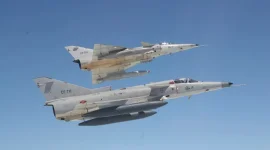- Views: 6K
- Replies: 15
The Pakistan Air Force (PAF) is undertaking a significant restructuring of its fighter aircraft fleet, introducing a mix of Chinese-developed jets. This strategy involves using the JF-17 Block 3 for lower-to-mid-level capabilities, the J-10C for mid-to-upper-level roles, and potentially acquiring the J-35 stealth fighter for top-tier missions.
While this approach appears to enhance Pakistan's air power significantly, a closer look suggests the complexities involved might present strategic advantages for the Indian Air Force (IAF).
This analysis examines the capabilities of each aircraft type, estimates their potential availability for missions, and considers the strategic implications for regional air power dynamics, particularly focusing on potential vulnerabilities in Pakistan's approach.
Understanding Pakistan's Multi-Tier Fighter Strategy
The PAF's plan involves distinct roles for each new platform:- JF-17 Block 3 (Lower/Mid-Tier): Developed jointly by Pakistan and China, this lightweight multi-role fighter is replacing older aircraft like the Mirage III/V and F-7P. Equipped with an Active Electronically Scanned Array (AESA) radar and improved avionics, it's considered a "4.5 generation" fighter. Reports suggest around 50 Block 3 aircraft are operational, with plans to increase this number significantly.
- J-10C (Mid/Upper-Tier): This Chinese 4.5-generation fighter features advanced systems, including AESA radar, and can carry long-range missiles. Pakistan has reportedly received about 25 J-10Cs, potentially aiming for 50 or more. It is seen as a counter to the IAF's Rafale and Su-30 MKI fleets.
- J-35 (Prospective Upper-Tier): Although not yet acquired, Pakistani officials have indicated interest in this Chinese fifth-generation stealth fighter. If procured, estimates suggest 40-50 units could enter service by 2030, intended to provide a technological edge through stealth and advanced sensor capabilities.
Challenges in Operational Readiness
A critical factor in air power is the operational rate – the percentage of aircraft available for missions at any given time. This depends heavily on maintenance schedules, the availability of spare parts, pilot training, and overall logistical support infrastructure. While official PAF figures are not public, estimates can be inferred:- JF-17 Block 3: Earlier versions reportedly achieved 60-65% readiness. The newer Block 3 might initially face challenges but benefits from local assembly experience at the Pakistan Aeronautical Complex (PAC). A 65% rate for a fleet of 50 would mean about 32-35 jets ready. However, reliance on Chinese supply chains for key components, like the RD-93MA engine (derived from a Russian design) and electronics, could pose risks.
- J-10C: Based on reported rates for China's large fleet (65-70%) and considering the PAF's smaller fleet size and integration phase, a similar 65-70% readiness seems plausible. This translates to roughly 16-18 mission-ready J-10Cs out of 25. Integrating this new platform requires significant training for pilots and ground crews.
- J-35 (Hypothetical): Fifth-generation fighters like the US F-35 often face lower readiness rates (around 50-60%) due to complexity. An optimistic estimate for the PAF operating the J-35 might be 55% readiness, yielding about 22 available aircraft from a fleet of 40. This depends heavily on robust Chinese support and Pakistan's ability to fund the demanding maintenance.
Logistical Strain and Potential Indian Advantage
Operating three distinct advanced fighter types simultaneously creates substantial logistical hurdles, particularly for a military with limited resources. Each aircraft requires different maintenance protocols, unique spare parts inventories, and separate training programs.Furthermore, the engines come from different sources or design lineages (Russian-derived for JF-17, Chinese WS-10 for J-10C, and likely a newer Chinese engine for J-35). Managing these diverse supply chains, especially under economic pressure or potential geopolitical friction, could impact readiness and the ability to sustain air operations during a conflict.
In contrast, the IAF benefits from greater uniformity in its primary fleets, particularly the large number of Su-30 MKIs and the growing Rafale force, potentially allowing for more efficient logistics and higher sustained sortie rates.
Estimates suggest that even with all three new types operational, the PAF might struggle to have more than 70-75 advanced fighters mission-ready at any given time (32 JF-17 Blk3 + 16 J-10C + 22 J-35 hypothetical).
The IAF, drawing from its larger fleets of Su-30 MKIs (~260+), Rafales (36), Mirage 2000s (~50), MiG-29s (~65) and the indigenous Tejas, can likely field significantly more mission-ready aircraft (potentially 150-200+ modern fighters depending on readiness assumptions), providing a numerical advantage for sustained operations.
Countering Stealth and Training Factors
While the potential acquisition of the J-35 introduces stealth capability, its combat effectiveness remains unproven. Modern air defence networks, like India's Integrated Air Defence System incorporating assets such as S-400 missile systems, Barak-8 missiles, AWACS, and upgraded fighter radars, are designed to detect and engage low-observable threats. Furthermore, the relatively small number of J-35s likely planned means they cannot dominate the airspace alone.Integrating sophisticated platforms like the J-10C and J-35 also demands extensive, years-long training for pilots and crews to develop effective operational doctrines. The IAF possesses considerable experience operating diverse high-tech platforms and participating in complex international exercises, potentially providing a tactical advantage in network-centric operations and beyond-visual-range combat.
Implications for Indian Defence Planning
The PAF's modernization efforts underscore the importance for India to continue its own air power development. Ongoing programs like the indigenous AMCA (Advanced Medium Combat Aircraft), potential further Rafale acquisitions, and the continued induction of Tejas variants (Mk1A and the planned Mk2) are crucial responses. India's focus on indigenous development also offers a potential advantage over reliance on foreign suppliers, which can be subject to external pressures.In conclusion, while Pakistan's acquisition of diverse Chinese fighter jets represents a notable modernization of its air force, the associated logistical complexities and potential limitations on operational readiness could present challenges for the PAF and strategic considerations for Indian defence planners.

